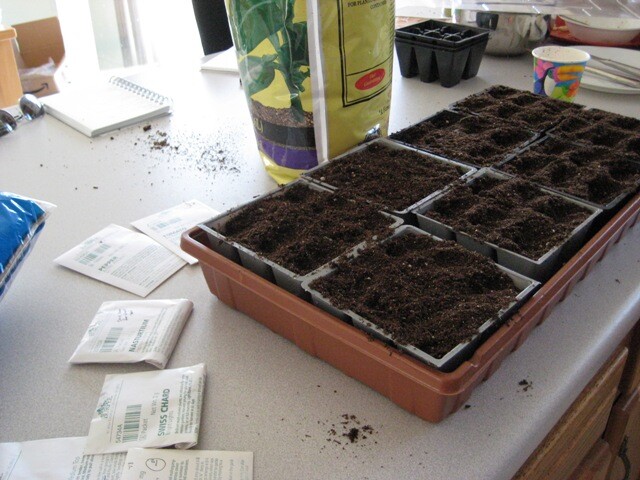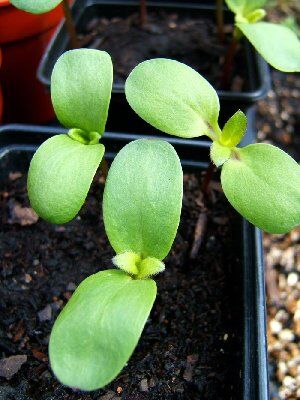Snow may be falling again outside, but the daffodils and crocuses I planted are still brightening up my yard–at least in a couple of places. Despite the fact that winter is not quite finished with much of the country, it’s time to think ahead to spring gardens–both vegetables and flowers.
The last frost date for most of Utah is Memorial Day, though most years the final frost is weeks earlier, so now is the time to start thinking about starting seeds indoors. Depending on where you live, your last frost date could be earlier or later. Check with your local extension service if you don’t have a good idea of when it it.
Many vegetables like broccoli, cauliflower, cabbage, and kale can be started indoors right now, and even lettuce, which will deal with cooler weather than the previously mentioned plants, can be sowed indoors four weeks before moving outside. Seed starting is easy, and doesn’t have to take a lot of expensive equipment. It can also save a great deal of money over buying started plants.
Most everywhere that sells seed has already got their displays up, so go on the hunt and see what seeds you can rustle up. Flowers that reseed themselves can be direct sown into the ground as soon as it is soft enough to be worked–right now if you live where I do…well, I’d wait until the snow melts, but the ground can be turned over with a minimum of effort. If you are going for a less structured look to your yard, and you aren’t afraid to let the weeds run for a couple of weeks while you wait to be able to tell them from the flowers, this is a simple way to go about it. Lettuce can be started the same way–just don’t expect it to germinate as quickly as it would indoors.

If you are going to start seedlings inside, there are a few basic requirements:
A fine seed starting soil (or good quality compost that isn’t full of big chunks). Any fine potting soil will do, so don’t worry about spending a mint, just buy whatever is available to you.
Some kind of container (paper cups, newspaper pots, peat pots, milk cartons–almost anything will work).
Light (I have a lamp that mimics sunlight and there are ‘grow’ florescent bulbs available, but any good florescent bulb will do a decent job for the short term.) Regular light bulbs don’t provide the right kind of light and will result in your plants being long and spindly. Windows also don’t offer enough light in most circumstances, so you’ll need to plan on at least a few hours of accessory lighting. Make sure you can place your light only a couple of inches above the top of your soil, and that the height it variable, so you can raise it as the seedlings grow. I have a florescent tube light that I place on books, with the seeds in between, then I add a book to raise the lamp as needed.
There are systems out there that cost hundreds of dollars, but with a little creativity, you don’t have to spend much at all.
Water.
Yep, that’s it. It doesn’t hurt to start seeds with a weak fertilizer–I recommend it. I often start seeds with one of those granulated, slow-release type because it feeds the plants constantly for a long time–and fertilizer is not one of those things where if some is good, more is better. Follow directions on your fertilizer labels as too much can burn the newly developing seedlings. In fact, going a little weaker than suggested is not a bad idea when you are just starting. Some bagged seed-starting soils come with fertilizer already in them, so check to see what you have.
Most seed packages will tell you how deep to plant, but if you buy in bulk or anything not in an original package, the general rule of thumb is four times as deep as the seed is long. If you don’t need many seeds for your garden, check around and see if someone else wants to split some. You might find a neighbor who also wants only a few plants and is willing to share.
Dampen the soil so it holds together when you squeeze it, but doesn’t drip water. When you are starting with dry potting soil, it will absorb more easily if the water is on the warm side, and once the soil is totally dried, it takes more work to get it to absorb water. I often put a bunch in a container of some kind, then add water and mix it with my hands until I reach the right consistency, especially with seeds.
I usually cut or punch holes in the bottom of my containers so I can bottom water them–this is a much easier way to keep consistent moisture to your growing plants.
Fill your containers. Push your seeds down and press on the soil just firmly enough that the seed will have contact with the medium, but not so much that the air is all pushed out of the soil. Then place the pots in a warm place. The room should be 70-75 degrees. There are bottom heating pads available and I understand they provide great results, but I’ve never tried one yet. Some people have had luck growing in egg cartons, but I’ve found it hard to keep the soil damp enough because there is so little in each compartment, and if you use the cardboard type you can’t let it touch a porous surface or the water will all wick away.
You don’t have to start with the light right away, since it takes a few days for the seeds to soften and the new plant to pop out of their shells, but within a few days of starting the seeds, you should have a light on them. I prefer to leave mine on all day to provide optimal conditions–unless I start them outside to begin with.

In my post about Winter Sowing, I mentioned putting your seeds in containers outside all winter and letting them sprout when they were ready. You can modify this in the spring, and do it now. Simply place your containers outside as soon as they are planted, into a place where they will get at least seven hours of direct sunlight. If you use open containers like disposable cups, cover them with clear plastic at night to prevent freezing. And actually, you can keep it covered all the time until your seedlings start to pop up. Just remember to vent the covering well when it warms up during the day or you’ll bake your babies.
Advantages to starting them outside includes a reduction in loss of plants to damping off disease, and not having to harden them off. Hardening off is when you move seedlings outside for increasing periods of time during the day over the course of several days to adjust them to being outside to minimize death before planting outside. For example, you might take them out for two hours one day, three the next, four the day after that, and so on.
Keep the soil damp, and watch the plants grow.

Great ideas. I’ve tried to start seeds inside before, but always kill them. Have I ever mentioned that neither of my thumbs are green?
I’m going to try some herbs again this year. Wish me luck!
Great info. The grow light is a good idea, as when I’ve started seeds in a window, they’re always spindly.
Unless you have a window box that receives sun most of the day, getting enough natural light indoors is nearly impossible, so some kind of grow light is a necessity. Thanks for the comments!